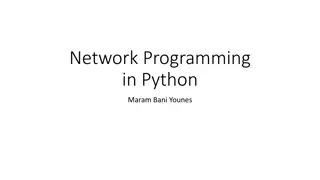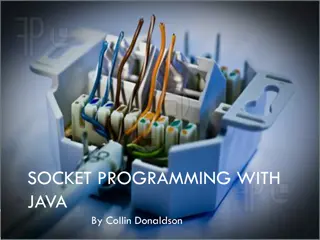Introduction to Socket Programming for Client/Server Applications
Gain insights into socket programming for building client/server applications that communicate using the Socket API. Explore the fundamentals of TCP sockets, application layers, terminology, and client/server socket interactions. Understand how sockets serve as doors between application processes and enable reliable data transfer, controlled by developers and operating systems.
Download Presentation

Please find below an Image/Link to download the presentation.
The content on the website is provided AS IS for your information and personal use only. It may not be sold, licensed, or shared on other websites without obtaining consent from the author. Download presentation by click this link. If you encounter any issues during the download, it is possible that the publisher has removed the file from their server.
E N D
Presentation Transcript
Socket Programming (MP1-) Presented by Wally
Socket programming Goal: learn how to build client/server application that communicate using sockets socket Socket API introduced in BSD4.1 UNIX, 1981 explicitly created, used, released by apps client/server paradigm two types of transport service via socket API: unreliable datagram reliable, byte stream-oriented a host-local, application-created, OS-controlled interface (a door ) into which application process can both send and receive messages to/from another application process 2: Application Layer 2
Socket-programming using TCP Socket: a door between application process and end-end- transport protocol (UCP or TCP) TCP service: reliable transfer of bytes from one process to another controlled by application developer controlled by application developer controlled by operating system process socket process socket TCP with buffers, variables controlled by operating system TCP with buffers, variables internet host or server host or server 2: Application Layer 3
Socket programming: Terminology Term IP(v4) Port Socket Format x.x.x.x N<65535 [memory/ resource] Example 192.168.0.1 80 s=socket( ) Analogy-phone Phone number Extension # Physical phone
Client/server socket interaction: TCP Server (stand-by, waiting for requests) Client (initiate the request) Create socket (Claim resources/ available phone) Create socket (Claim resources/ available phone) Bind port - (Claim ID on this machine/ get a phone extension No.) (Don t care about public port/ phone #) Listen/ accept Connect (Wait for connections/ Wait for phone call) (connect to server/ call others) Send/ receive (Communication/ Chat on phone) Send/ receive (Communication/ Chat on phone) Close socket Close socket (End communication/ Hang up the phone) (End communication/ Hang up the phone) Red word: wait for the other side
Client/server socket interaction: TCP Server (stand-by, waiting for requests) 1 Client (initiate the request) 4 Create socket (Claim resources/ available phone) Create socket (Claim resources/ available phone) Bind port 2 - (Claim ID on this machine/ get a phone extension No.) (Don t care about public port/ phone #) 5 3 Listen/ accept Connect (Wait for connections/ Wait for phone call) (connect to server/ call others) 6 Send/ receive (Communication/ Chat on phone) Send/ receive (Communication/ Chat on phone) 7/8 6 7/8 Close socket Close socket (End communication/ Hang up the phone) (End communication/ Hang up the phone) Red word: wait for the other side
Socket programming with TCP Client must contact server server process must first be running server must have created socket (door) that welcomes client s contact When contacted by client, server TCP creates new socket for server process to communicate with client allows server to talk with multiple clients source port numbers used to distinguish clients (more in Chap 3) Client contacts server by: creating client-local TCP socket specifying IP address, port number of server process When client creates socket: client TCP establishes connection to server TCP application viewpoint TCP provides reliable, in-order transfer of bytes ( pipe ) between client and server 2: Application Layer 7
Client/server socket interaction: TCP Server (stand-by, waiting for requests) Client (initiate the request) Create socket (Claim resources/ available phone) Create socket (Claim resources/ available phone) Bind port (Claim ID on this machine/ get a phone extension No.) Listen/ accept Fork/ New thread Connect (connect to server/ call others) Parent Child Send/ receive (Communication/ Chat on phone) Send/ receive (Communication/ Chat on phone) Close socket Close socket (End communication/ Hang up the phone) (End communication/ Hang up the phone)
Multiplexing/demultiplexing Demultiplexing at rcv host: Multiplexing at send host: gathering data from multiple sockets, enveloping data with header (later used for demultiplexing) delivering received segments to correct socket = socket = process P4 application P1 P1 P2 P3 application application transport transport transport network network network link link link physical physical physical host 3 host 2 host 1 Transport Layer 3-9
How demultiplexing works host receives IP datagrams each datagram has source IP address, destination IP address each datagram carries 1 transport- layer segment each segment has source, destination port number host uses IP addresses & port numbers to direct segment to appropriate socket 32 bits source port # dest port # other header fields application data (message) Analogous to airport shuttles Shuttles MUX passengers and take them to downtown -- DeMUX at different locations TCP/UDP segment format Transport Layer 3- 10
Connectionless demultiplexing When host receives UDP segment: checks destination port number in segment directs UDP segment to socket with that port number IP datagrams with different source IP addresses and/or source port numbers directed to same socket Create sockets with port numbers: DatagramSocket mySocket1 = new DatagramSocket(99111); DatagramSocket mySocket2 = new DatagramSocket(99222); UDP socket identified by two- tuple: (dest IP address, dest port number) Transport Layer 3- 11
Connectionless demux (cont) DatagramSocket serverSocket = new DatagramSocket(6428); P1 P1 P2 P3 SP: 6428 DP: 9157 SP: 6428 DP: 5775 SP: 9157 DP: 6428 SP: 5775 DP: 6428 client IP: A Client IP:B server IP: C SP provides return address Transport Layer 3- 12
Connection-oriented demux TCP socket identified by 4- tuple: source IP address source port number dest IP address dest port number recv host uses all four values to direct segment to appropriate socket Server host may support many simultaneous TCP sockets: each socket identified by its own 4-tuple Web servers have different sockets for each connecting client non-persistent HTTP will have different socket for each request Transport Layer 3- 13
Connection-oriented demux (cont) = process = socket P1 P2 P6 P1 P4 P5 P3 SP: 5775 DP: 80 S-IP: B D-IP:C SP: 9157 DP: 80 S-IP: A D-IP:C SP: 9157 DP: 80 S-IP: B client IP: A Client IP:B server IP: C D-IP:C Transport Layer 3- 14
Connection-oriented demux: Threaded Web Server = socket = process P1 P2 P1 P4 P3 SP: 5775 DP: 80 S-IP: B D-IP:C SP: 9157 DP: 80 S-IP: A D-IP:C SP: 9157 DP: 80 S-IP: B client IP: A Client IP:B server IP: C D-IP:C Transport Layer 3- 15























